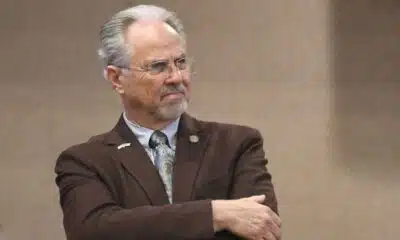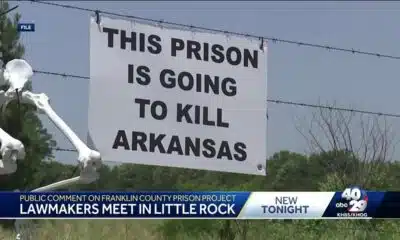Kaiser Health News
Death and Redemption in an American Prison
Markian Hawryluk
Wed, 21 Feb 2024 10:00:00 +0000
Steven Garner doesn’t like to talk about the day that changed his life. A New Orleans barroom altercation in 1990 escalated to the point where Garner, then 18, and his younger brother Glenn shot and killed another man. The Garners claimed self-defense, but a jury found them guilty of second-degree murder. They were sentenced to life in prison without parole.
When Garner entered the gates at Louisiana State Penitentiary in Angola, Louisiana, he didn’t know what to expect. The maximum security facility has been dubbed “America’s Bloodiest Prison” and its brutal conditions have made headlines for decades.
“Sometimes when you’re in a dark place, you find out who you really are and what you wish you could be,” Garner said. “Even in darkness, I could be a light.”
It wasn’t until five years later that Garner would get his chance to show everyone he wasn’t the hardened criminal they thought he was. When the prison warden, Burl Cain, decided to start the nation’s first prison hospice program, Garner volunteered.
In helping dying inmates, Garner believed he could claw back some meaning to the life he had nearly squandered in the heat of the moment. For the next 25 years, he cared for his fellow inmates, prisoners in need of help and compassion at the end of their lives.
The Angola program started by Cain, with the help of Garner and others, has since become a model. Today at least 75 of the more than 1,200 state and federal penal institutions nationwide have implemented formal hospice programs. Yet as America’s prison population ages, more inmates are dying behind bars of natural causes and few prisons have been able to replicate Angola’s approach.
Garner hopes to change that. But first he had to redeem himself.
‘Life Means Life’
Garner, the son of a longshoreman, was born and raised in New Orleans as one of seven kids who kept their mother busy at home. He attended Catholic primary school and played football at Booker T. Washington High School. After graduating, Garner worked for a garbage collection company, then for an ice cream manufacturer, testing deliveries of milk to make sure they hadn’t been watered down.
None of that experience would help him at Angola, where violence seemed to be everywhere. Garner remembered the endless stream of ambulances rolling through the prison gates.
“All day long: Somebody has gotten stabbed, somebody had gotten into a bad fight, blood everywhere,” he said.
Cain arrived at Angola in 1995, three years into Garner’s life sentence. In 1997, the warden came across a newspaper article about a hospice program in Baton Rouge, the state capital.
“I realized that if we did hospice, I wouldn’t have to do that rush at the end of life. We wouldn’t have to put them in an ambulance and send them to the hospital,” Cain said. “We could let them die in peace and not have to do all that.”
At first, the prison’s medical staff objected, worried about the cost. But Cain put his foot down. He hired a hospice nurse to run the program, and inmates would provide the day-to-day care at no cost.
Cain sought volunteers and funding from what he called the prison’s “clubs and organizations” — the Aryan Brotherhood, the Black Panthers, as well as the religious congregations within the prison walls. “All of y’all one day are going to be in hospice,” he said he told them.
It was no exaggeration. In Louisiana, as the saying goes, life means life, with no chance of parole. And at that time, 85% of those sent to Angola would die there, according to Cain and others.
“We buried more people a year than we released out the front gate,” Cain said.
Many serving life sentences no longer had family outside the prison walls, and for those who did, their families often could not afford to pay for a funeral or burial spot. So, the prison would bury the bodies at Angola. When the first cemetery was filled, the prison established another.
Initially, inmates were buried in cardboard boxes. But during one funeral, the body fell out of the box onto the ground. Cain vowed that would never happen again and instructed inmates working in carpentry to learn to make wooden caskets. The prison then provided caskets for any inmate in Louisiana whose body was not claimed by their family. The late Rev. Billy Graham and his wife were buried in two plain wooden caskets made at Angola.
Cain saw the hospice program as part of his approach of rehabilitation through morality and Christian principles. Cain started a seminary program at Angola, had the prisoners build several churches on its grounds, and considered hospice “the icing on the cake.”
The Early Days
Garner had never heard of hospice.
He was among the first 40 volunteers at the prison, hand-picked for their clean disciplinary records and trained by two social workers from a New Orleans hospital in 1998.
Isolation cells were remade to serve as hospice rooms. The volunteers repainted the walls and draped curtains to hide the wire mesh covering the windows. They brought in nightstands and tables, TVs, and air conditioning.
Soon, it became clear the prison would have to change its rules to accommodate hospice. Before the program existed, inmates weren’t allowed to touch each other. They couldn’t even assist someone out of a wheelchair.
“They would actually push them into a room and wait on the nurse or doctor or somebody else to assist them,” Garner said. “They would die alone. They had nobody to talk to them, other than nurses and doctors making their rounds. They really didn’t have nobody that they could relate to.”
The volunteers were issued hospice T-shirts that allowed them free movement through the prison. Cain made it clear to the correctional officers and the staff that if someone was wearing that shirt, it was like hearing directly from the warden.
“He had to rewrite policies so everything that a hospice program can do in society, that program can do as well inside corrections,” Garner said.
The primary rule of the hospice program was that no one would die alone. When death was imminent, the hospice volunteers conducted a vigil round-the-clock.
The program used medications, including opioids, for the palliative care of patients, though the inmate volunteers were not allowed to administer them.
The first hospice patient Garner saw die was a man the prisoners called Baby. Standing just 4-foot-5, he was sought out by other inmates for his self-taught legal expertise. In 1998, as Baby was dying from cirrhosis, a disease of the liver, inmates rushed in to get his advice one last time.
“So many people wanted to see him, we just didn’t have enough room to take everybody in,” Garner said. “We used to have to do increments of 10 guys or whatever.”
Baby had taken care of everybody else. Now it was their time to take care of him.
Most of the hospice volunteers were serving life sentences, and many, like Garner, had taken someone’s life to get there. But holding a man’s hand as he took his last breath provided a new perspective.
“We all don’t know much about death, only what we see through the eyes of somebody who was going through that transition,” Garner said. “It was new to me, because I didn’t understand it in its entirety until I got into the program.”
The hospice volunteers became the conduit for inmates to get messages to their dying friends.
But more importantly, they functioned as confidants, giving dying inmates a last chance to get something off their chest.
“You become their hands, you become their eyes, you become their feet, you become their thinking sometimes,” Garner said. “They’re so vulnerable to where you actually have to be so mindful and careful to carry out their will.”
In a place where people prey on weakness, hospice volunteers shared in each patient’s vulnerability. Instead of assaulting, they assisted. Instead of sowing conflict, they spread peace.
“Just a touch makes a big difference, when a person can’t see or a person can’t hear,” Garner said.
‘What About Quilting?’
As the years passed, hospice deaths became more prevalent, with two to three inmates dying a week. The prison population was graying, and not just at Angola. According to federal statistics, from 1991 to 2021, the percentage of state and federal inmates 55 and older grew from 3% to 15%. And in 2020, 30% of those serving life sentences were at least 55 years old.
Throughout the 2000s, the Angola hospice saw increasing deaths from cancer, hepatitis C, and AIDS. But mostly, the patients’ bodies were wearing out. Most had come from low-income backgrounds and arrived at Angola in less-than-optimal health. Prison took a further toll, accelerating aging and exacerbating chronic conditions.
The hospice volunteers tried to grant the dying inmates’ often modest last requests: fresh fruit, a peanut butter and jelly sandwich, some potato chips.
“A bag of chips, to people in society, it’s like, ‘Oh man, that ain’t it,’” Garner said. “But to somebody that has a taste for it or for somebody that’s about to pass away, their wanting is everything.”
But those wishes cost money. In 2000, the prison volunteers were brainstorming ways to make the program self-sufficient.
“What about quilting?” suggested Tanya Tillman, the hospice nurse.
The room fell silent, Garner recalled. The volunteers looked around nervously.
“That was not something that a male inmate wanted to hear,” Garner said.
But the other “clubs and organizations,” as Cain called the inmate groups, were also raising money through fundraisers. They needed something that would stand out, something they would have no competition over.
“And so we voted,” Garner said. “Quilting it was.”
None of the men had quilted before. Some women came to teach them the basics, but mostly they learned through trial and error.
“I just put a sewing machine in front of me,” Garner said. “I knew all the do’s and don’ts, but I didn’t know how to take and cut fabric, and put fabric together, and make it make sense.”
They auctioned off their first quilt at the Angola Prison Rodeo, a biannual event in which prisoners compete in traditional rodeo events. It attracts people from all over the world.
At one point, Garner and his team were making 125 or more quilts a year: throws, kings, and queens.
“Within five years, we was on the front cover of Minnesota Alumni magazine,” Garner said, referencing the University of Minnesota Alumni Association’s publication. “In 2007, we were on another front cover, Imagine Louisiana magazine, and then in 10 years, we was in documentaries with Oprah Winfrey,” Garner said.
The Oprah Winfrey Network profiled the prison hospice program in 2011 in a documentary titled “Serving Life.”
Quilts made in Angola now hang in The Historic New Orleans Collection, the Smithsonian Institution’s National Museum of African American History and Culture in Washington, D.C., and the National Hospice and Palliative Care Organization building in Alexandria, Virginia.
One of the first quilts Garner made was a passage quilt, used instead of a plain white sheet to cover bodies being transported to the morgue. The quilt showed the clouds opening and angels receiving the inmate into heaven. It was adorned with the words, “I’m free, no more chains holding me.” Garner made another quilt to drape over the casket during funeral processions.
The program used the proceeds from the sale of other quilts to stock a cabinet with food and other sundries the hospice patients might need. If a patient’s family did not have the money to travel to Louisiana to see their loved one in his final days, the program would pay for their airline tickets. The family could stay overnight in the patient’s room, something that was unheard of in a maximum security prison.
The hospice program broke a lot of prison norms, and seemingly anything was on the table. When one hospice patient’s dying wish was to go fishing, the volunteers got the warden’s approval and brought a group of inmates with him.
The Mississippi River surrounds the Angola area on three sides, and the staff baited a fishing hole for days before the excursion so fish would be biting when the dying man arrived.
The fishing excursion became an annual event.
“You see the smile on their faces catching those fish,” Cain said. “They forgot all about that they were terminal.”
He added, “It teaches us to normalize our prisons and quit making them abnormal, bad places, and make it make people think they’re bad people. Hospice is the best example of all, to teach you to give back and then you will heal, and you won’t have more victims when you get out of prison.”
A Change in Prison Culture
Soon the impact of hospice was being felt well beyond the volunteers and their patients.
“It’s changed the culture of their facilities. It changed the general population,” said Jamey Boudreaux, the executive director of the Louisiana-Mississippi Hospice and Palliative Care Organization. “The general population sees people caring and it’s kind of contagious.”
When Boudreaux was hired in 1998, his first task from the board of directors was to shut down the hospice at Angola.
“They’re calling something hospice,” he recalled the board telling him, “and we can just see that there’s going to be some sort of big scandal and hospice is going to get a bad name.”
He called the prison and Cain invited him to come see the hospice program in person. Boudreaux, who had never been in a prison before, sat through a two-hour meeting with hospice volunteers and correctional officers.
He didn’t shut it down. Instead, he continued to attend monthly meetings at the prison for the next five years. Eventually, the administrators asked him if he’d feel comfortable being there alone with the volunteers, so they could speak more freely.
“I got to know these guys and they were genuinely committed to this whole notion of taking care of people at the end of life,” he said. “For some of them, it was a way to find redemption. For others, it was an affirmation that, ‘I don’t deserve to be in this place. And this gives me a very safe place to spend my time in prison.’”
The concept of prison hospice began to spread. In 2006, and again in 2012, Angola hosted a prison hospice conference. Now, five of the eight state prison facilities in Louisiana have inmate volunteer hospice programs. Nationwide, about 75 to 80 hospice programs operate behind bars.
“Most are pretty basic,” said Cordt Kassner, a consultant with Hospice Analytics in Colorado Springs, Colorado. “Angola is head and shoulders the model; the best one, period.”
Regaining Freedom
Between caring for patients, sewing quilts, and working in the prison library, Garner had little time for anything else, though he continued to push for his case to be reviewed to earn his freedom.
Then, during the covid-19 pandemic, the quilters were asked to sew masks for the prison. The prison set up shifts so prisoners could maximize use of the sewing machines, keeping them running 24 hours a day. Masks were shipped to other prisons as well. Garner estimated he made 25,000 masks.
“I actually had to take time away from my work, from trying to get out of that place, working legal work and stuff,” Garner said.
Finally, in 2021, his case was reviewed by the Orleans Parish District Attorney’s Civil Rights Division. A judge agreed with the district attorney that in receiving life sentences at Angola, Garner and his brother had been oversentenced. They offered the brothers a deal: They could plead guilty to the lesser charge of manslaughter and be released for time served.
Garner had to think about it. His lawyers told him he likely had a good case to sue and be compensated for the many years he had spent in prison. But if he took the deal, he couldn’t sue.
“I could fight it or gain my freedom,” he said.
His family wanted the brothers home. Garner had lost his mother, his father, two brothers, and an aunt while behind bars. He and his brother opted to forgo any money that might come their way and secured their release.
“Steven Garner came in as a horrible criminal,” Cain said. “But he left us a wonderful man.”
Most of Garner’s immediate family had moved to the Colorado Springs area after being displaced by Hurricane Katrina, and in January 2022, after serving 31 years in prison, he joined them.
Spreading the Message
Quilting is an art of putting scraps of fabric together, making everything fit coherently. Now out of prison, Garner had to find a way to make all the pieces of his life fit together as well. He found a job at a warehouse, rented a home near his family, and bought himself a car.
At his prison job, he made 20 cents an hour — $8 a week, $32 a month — that he used to buy soap and deodorant. It’s a strange feeling today, he said, to be able to go into a store and buy something that costs more than $32.
Now 51, he has missed the prime years of his adult life. But rather than trying to make up for lost time in some grand hedonistic rush, Garner went back to what had saved him. He started a consulting business to help prisons implement hospice programs.
Over the past two years, he has delivered speeches at state hospice association conferences, and last year he spoke at a meeting of the Colorado Bar Association.
For many hospice veterans, prison hospice reminds them of the initial days of hospice, when it was primarily a nonprofit entity, run by people called to serve others.
“You would be hard-pressed to find a hospice provider that’s willing to support hospice in correctional facilities,” said Kim Huffington, chief nursing officer at Sangre de Cristo Community Care, a hospice based in Pueblo, Colorado. “Hospice as an industry has undergone a lot of change in the last 10 years and there’s a lot more for-profit hospices than there used to be.”
Yet talking to Garner, she said, has reignited her passion for the field.
“In many situations, we tend to dehumanize what we don’t understand or have experience with,” Huffington said. “The way he can make you see what he’s experienced through his eyes is something that I take away from every conversation with him.”
In September, Garner went back to prison, this time at the behest of the Colorado Department of Corrections, which wanted his advice on how to restart a defunct hospice program at Colorado Territorial Correctional Facility in Cañon City.
It was a surreal experience entering a prison again, dropping his keys in a little basket at the security screening, knowing he’d get them back shortly.
“It was really just another experience in my life,” Garner reflected, “that I can come and go, rather than come and stay.”
——————————
By: Markian Hawryluk
Title: Death and Redemption in an American Prison
Sourced From: kffhealthnews.org/news/article/prison-hospice-redemption-life-death-angola-louisiana/
Published Date: Wed, 21 Feb 2024 10:00:00 +0000
Did you miss our previous article…
https://www.biloxinewsevents.com/fourth-wave-of-opioid-epidemic-crashes-ashore-propelled-by-fentanyl-and-meth/
Kaiser Health News
How To Find the Right Medical Rehab Services
Rehabilitation therapy can be a godsend after hospitalization for a stroke, a fall, an accident, a joint replacement, a severe burn, or a spinal cord injury, among other conditions. Physical, occupational, and speech therapy are offered in a variety of settings, including at hospitals, nursing homes, clinics, and at home. It’s crucial to identify a high-quality, safe option with professionals experienced in treating your condition.
What kinds of rehab therapy might I need?
Physical therapy helps patients improve their strength, stability, and movement and reduce pain, usually through targeted exercises. Some physical therapists specialize in neurological, cardiovascular, or orthopedic issues. There are also geriatric and pediatric specialists. Occupational therapy focuses on specific activities (referred to as “occupations”), often ones that require fine motor skills, like brushing teeth, cutting food with a knife, and getting dressed. Speech and language therapy help people communicate. Some patients may need respiratory therapy if they have trouble breathing or need to be weaned from a ventilator.
Will insurance cover rehab?
Medicare, health insurers, workers’ compensation, and Medicaid plans in some states cover rehab therapy, but plans may refuse to pay for certain settings and may limit the amount of therapy you receive. Some insurers may require preauthorization, and some may terminate coverage if you’re not improving. Private insurers often place annual limits on outpatient therapy. Traditional Medicare is generally the least restrictive, while private Medicare Advantage plans may monitor progress closely and limit where patients can obtain therapy.
Should I seek inpatient rehabilitation?
Patients who still need nursing or a doctor’s care but can tolerate three hours of therapy five days a week may qualify for admission to a specialized rehab hospital or to a unit within a general hospital. Patients usually need at least two of the main types of rehab therapy: physical, occupational, or speech. Stays average around 12 days.
How do I choose?
Look for a place that is skilled in treating people with your diagnosis; many inpatient hospitals list specialties on their websites. People with complex or severe medical conditions may want a rehab hospital connected to an academic medical center at the vanguard of new treatments, even if it’s a plane ride away.
“You’ll see youngish patients with these life-changing, fairly catastrophic injuries,” like spinal cord damage, travel to another state for treatment, said Cheri Blauwet, chief medical officer of Spaulding Rehabilitation in Boston, one of 15 hospitals the federal government has praised for cutting-edge work.
But there are advantages in selecting a hospital close to family and friends who can help after you are discharged. Therapists can help train at-home caregivers.
How do I find rehab hospitals?
The discharge planner or caseworker at the acute care hospital should provide options. You can search for inpatient rehabilitation facilities by location or name through Medicare’s Care Compare website. There you can see how many patients the rehab hospital has treated with your condition — the more the better. You can search by specialty through the American Medical Rehabilitation Providers Association, a trade group that lists its members.
Find out what specialized technologies a hospital has, like driving simulators — a car or truck that enable a patient to practice getting in and out of a vehicle — or a kitchen table with utensils to practice making a meal.
How can I be confident a rehab hospital is reliable?
It’s not easy: Medicare doesn’t analyze staffing levels or post on its website results of safety inspections as it does for nursing homes. You can ask your state public health agency or the hospital to provide inspection reports for the last three years. Such reports can be technical, but you should get the gist. If the report says an “immediate jeopardy” was called, that means inspectors identified safety problems that put patients in danger.
The rate of patients readmitted to a general hospital for a potentially preventable reason is a key safety measure. Overall, for-profit rehabs have higher readmission rates than nonprofits do, but there are some with lower readmission rates and some with higher ones. You may not have a nearby choice: There are fewer than 400 rehab hospitals, and most general hospitals don’t have a rehab unit.
You can find a hospital’s readmission rates under Care Compare’s quality section. Rates lower than the national average are better.
Another measure of quality is how often patients are functional enough to go home after finishing rehab rather than to a nursing home, hospital, or health care institution. That measure is called “discharge to community” and is listed under Care Compare’s quality section. Rates higher than the national average are better.
Look for reviews of the hospital on Yelp and other sites. Ask if the patient will see the same therapist most days or a rotating cast of characters. Ask if the therapists have board certifications earned after intensive training to treat a patient’s particular condition.
Visit if possible, and don’t look only at the rooms in the hospital where therapy exercises take place. Injuries often occur in the 21 hours when a patient is not in therapy, but in his or her room or another part of the building. Infections, falls, bedsores, and medication errors are risks. If possible, observe whether nurses promptly respond to call lights, seem overloaded with too many patients, or are apathetically playing on their phones. Ask current patients and their family members if they are satisfied with the care.
What if I can’t handle three hours of therapy a day?
A nursing home that provides rehab might be appropriate for patients who don’t need the supervision of a doctor but aren’t ready to go home. The facilities generally provide round-the-clock nursing care. The amount of rehab varies based on the patient. There are more than 14,500 skilled nursing facilities in the United States, 12 times as many as hospitals offering rehab, so a nursing home may be the only option near you.
You can look for them through Medicare’s Care Compare website. (Read our previous guide to finding a good, well-staffed home to know how to assess the overall staffing.)
What if patients are too frail even for a nursing home?
They might need a long-term care hospital. Those specialize in patients who are in comas, on ventilators, and have acute medical conditions that require the presence of a physician. Patients stay at least four weeks, and some are there for months. Care Compare helps you search. There are fewer than 350 such hospitals.
I’m strong enough to go home. How do I receive therapy?
Many rehab hospitals offer outpatient therapy. You also can go to a clinic, or a therapist can come to you. You can hire a home health agency or find a therapist who takes your insurance and makes house calls. Your doctor or hospital may give you referrals. On Care Compare, home health agencies list whether they offer physical, occupational, or speech therapy. You can search for board-certified therapists on the American Physical Therapy Association’s website.
While undergoing rehab, patients sometimes move from hospital to nursing facility to home, often at the insistence of their insurers. Alice Bell, a senior specialist at the APTA, said patients should try to limit the number of transitions, for their own safety.
“Every time a patient moves from one setting to another,” she said, “they’re in a higher risk zone.”
KFF Health News is a national newsroom that produces in-depth journalism about health issues and is one of the core operating programs at KFF—an independent source of health policy research, polling, and journalism. Learn more about KFF.
USE OUR CONTENT
This story can be republished for free (details).
KFF Health News is a national newsroom that produces in-depth journalism about health issues and is one of the core operating programs at KFF—an independent source of health policy research, polling, and journalism. Learn more about KFF.
Subscribe to KFF Health News’ free Morning Briefing.
This article first appeared on KFF Health News and is republished here under a Creative Commons license.
The post How To Find the Right Medical Rehab Services appeared first on kffhealthnews.org
Note: The following A.I. based commentary is not part of the original article, reproduced above, but is offered in the hopes that it will promote greater media literacy and critical thinking, by making any potential bias more visible to the reader –Staff Editor.
Political Bias Rating: Centrist
This article from KFF Health News provides a comprehensive, fact-based guide to rehabilitation therapy options and how to navigate insurance, care settings, and provider quality. It avoids ideological framing and presents information in a neutral, practical tone aimed at helping consumers make informed medical decisions. While it touches on Medicare and private insurance policies, it does so without political commentary or value judgments, and no partisan viewpoints or advocacy positions are evident. The focus remains on patient care, safety, and informed choice, supporting a nonpartisan, service-oriented approach to health reporting.
Kaiser Health News
States Brace for Reversal of Obamacare Coverage Gains Under Trump’s Budget Bill
Shorter enrollment periods. More paperwork. Higher premiums. The sweeping tax and spending bill pushed by President Donald Trump includes provisions that would not only reshape people’s experience with the Affordable Care Act but, according to some policy analysts, also sharply undermine the gains in health insurance coverage associated with it.
The moves affect consumers and have particular resonance for the 19 states (plus Washington, D.C.) that run their own ACA exchanges.
Many of those states fear that the additional red tape — especially requirements that would end automatic reenrollment — would have an outsize impact on their policyholders. That’s because a greater percentage of people in those states use those rollovers versus shopping around each year, which is more commonly done by people in states that use the federal healthcare.gov marketplace.
“The federal marketplace always had a message of, ‘Come back in and shop,’ while the state-based markets, on average, have a message of, ‘Hey, here’s what you’re going to have next year, here’s what it will cost; if you like it, you don’t have to do anything,’” said Ellen Montz, who oversaw the federal ACA marketplace under the Biden administration as deputy administrator and director at the Center for Consumer Information and Insurance Oversight. She is now a managing director with the Manatt Health consulting group.
Millions — perhaps up to half of enrollees in some states — may lose or drop coverage as a result of that and other changes in the legislation combined with a new rule from the Trump administration and the likely expiration at year’s end of enhanced premium subsidies put in place during the covid-19 pandemic. Without an extension of those subsidies, which have been an important driver of Obamacare enrollment in recent years, premiums are expected to rise 75% on average next year. That’s starting to happen already, based on some early state rate requests for next year, which are hitting double digits.
“We estimate a minimum 30% enrollment loss, and, in the worst-case scenario, a 50% loss,” said Devon Trolley, executive director of Pennie, the ACA marketplace in Pennsylvania, which had 496,661 enrollees this year, a record.
Drops of that magnitude nationally, coupled with the expected loss of Medicaid coverage for millions more people under the legislation Trump calls the “One Big Beautiful Bill,” could undo inroads made in the nation’s uninsured rate, which dropped by about half from the time most of the ACA’s provisions went into effect in 2014, when it hovered around 14% to 15% of the population, to just over 8%, according to the most recent data.
Premiums would rise along with the uninsured rate, because older or sicker policyholders are more likely to try to jump enrollment hurdles, while those who rarely use coverage — and are thus less expensive — would not.
After a dramatic all-night session, House Republicans passed the bill, meeting the president’s July 4 deadline. Trump is expected to sign the measure on Independence Day. It would increase the federal deficit by trillions of dollars and cut spending on a variety of programs, including Medicaid and nutrition assistance, to partly offset the cost of extending tax cuts put in place during the first Trump administration.
The administration and its supporters say the GOP-backed changes to the ACA are needed to combat fraud. Democrats and ACA supporters see this effort as the latest in a long history of Republican efforts to weaken or repeal Obamacare. Among other things, the legislation would end several changes put in place by the Biden administration that were credited with making it easier to sign up, such as lengthening the annual open enrollment period and launching a special program for very low-income people that essentially allows them to sign up year-round.
In addition, automatic reenrollment, used by more than 10 million people for 2025 ACA coverage, would end in the 2028 sign-up season. Instead, consumers would have to update their information, starting in August each year, before the close of open enrollment, which would end Dec. 15, a month earlier than currently.
That’s a key change to combat rising enrollment fraud, said Brian Blase, president of the conservative Paragon Health Institute, because it gets at what he calls the Biden era’s “lax verification requirements.”
He blames automatic reenrollment, coupled with the availability of zero-premium plans for people with lower incomes that qualify them for large subsidies, for a sharp uptick in complaints from insurers, consumers, and brokers about fraudulent enrollments in 2023 and 2024. Those complaints centered on consumers’ being enrolled in an ACA plan, or switched from one to another, without authorization, often by commission-seeking brokers.
In testimony to Congress on June 25, Blase wrote that “this simple step will close a massive loophole and significantly reduce improper enrollment and spending.”
States that run their own marketplaces, however, saw few, if any, such problems, which were confined mainly to the 31 states using the federal healthcare.gov.
The state-run marketplaces credit their additional security measures and tighter control over broker access than healthcare.gov for the relative lack of problems.
“If you look at California and the other states that have expanded their Medicaid programs, you don’t see that kind of fraud problem,” said Jessica Altman, executive director of Covered California, the state’s Obamacare marketplace. “I don’t have a single case of a consumer calling Covered California saying, ‘I was enrolled without consent.’”
Such rollovers are common with other forms of health insurance, such as job-based coverage.
“By requiring everyone to come back in and provide additional information, and the fact that they can’t get a tax credit until they take this step, it is essentially making marketplace coverage the most difficult coverage to enroll in,” said Trolley at Pennie, 65% of whose policyholders were automatically reenrolled this year, according to KFF data. KFF is a health information nonprofit that includes KFF Health News.
Federal data shows about 22% of federal sign-ups in 2024 were automatic-reenrollments, versus 58% in state-based plans. Besides Pennsylvania, the states that saw such sign-ups for more than 60% of enrollees include California, New York, Georgia, New Jersey, and Virginia, according to KFF.
States do check income and other eligibility information for all enrollees — including those being automatically renewed, those signing up for the first time, and those enrolling outside the normal open enrollment period because they’ve experienced a loss of coverage or other life event or meet the rules for the low-income enrollment period.
“We have access to many data sources on the back end that we ping, to make sure nothing has changed. Most people sail through and are able to stay covered without taking any proactive step,” Altman said.
If flagged for mismatched data, applicants are asked for additional information. Under current law, “we have 90 days for them to have a tax credit while they submit paperwork,” Altman said.
That would change under the tax and spending plan before Congress, ending presumptive eligibility while a person submits the information.
A white paper written for Capital Policy Analytics, a Washington-based consultancy that specializes in economic analysis, concluded there appears to be little upside to the changes.
While “tighter verification can curb improper enrollments,” the additional paperwork, along with the expiration of higher premiums from the enhanced tax subsidies, “would push four to six million eligible people out of Marketplace plans, trading limited fraud savings for a surge in uninsurance,” wrote free market economists Ike Brannon and Anthony LoSasso.
“Insurers would be left with a smaller, sicker risk pool and heightened pricing uncertainty, making further premium increases and selective market exits [by insurers] likely,” they wrote.
KFF Health News is a national newsroom that produces in-depth journalism about health issues and is one of the core operating programs at KFF—an independent source of health policy research, polling, and journalism. Learn more about KFF.
USE OUR CONTENT
This story can be republished for free (details).
KFF Health News is a national newsroom that produces in-depth journalism about health issues and is one of the core operating programs at KFF—an independent source of health policy research, polling, and journalism. Learn more about KFF.
Subscribe to KFF Health News’ free Morning Briefing.
This article first appeared on KFF Health News and is republished here under a Creative Commons license.
The post States Brace for Reversal of Obamacare Coverage Gains Under Trump’s Budget Bill appeared first on kffhealthnews.org
Note: The following A.I. based commentary is not part of the original article, reproduced above, but is offered in the hopes that it will promote greater media literacy and critical thinking, by making any potential bias more visible to the reader –Staff Editor.
Political Bias Rating: Center-Left
This content presents a critique of Republican-led changes to the Affordable Care Act, emphasizing potential negative impacts such as increased premiums, reduced enrollment, and the erosion of coverage gains made under the ACA. It highlights the perspective of policy analysts and state officials who express concern over these measures, while also presenting conservative viewpoints, particularly those focusing on fraud reduction. Overall, the tone and framing lean toward protecting the ACA and its expansions, which traditionally aligns with Center-Left media analysis.
Kaiser Health News
Dual Threats From Trump and GOP Imperil Nursing Homes and Their Foreign-Born Workers
In a top-rated nursing home in Alexandria, Virginia, the Rev. Donald Goodness is cared for by nurses and aides from various parts of Africa. One of them, Jackline Conteh, a naturalized citizen and nurse assistant from Sierra Leone, bathes and helps dress him most days and vigilantly intercepts any meal headed his way that contains gluten, as Goodness has celiac disease.
“We are full of people who come from other countries,” Goodness, 92, said about Goodwin House Alexandria’s staff. Without them, the retired Episcopal priest said, “I would be, and my building would be, desolate.”
The long-term health care industry is facing a double whammy from President Donald Trump’s crackdown on immigrants and the GOP’s proposals to reduce Medicaid spending. The industry is highly dependent on foreign workers: More than 800,000 immigrants and naturalized citizens comprise 28% of direct care employees at home care agencies, nursing homes, assisted living facilities, and other long-term care companies.
But in January, the Trump administration rescinded former President Joe Biden’s 2021 policy that protected health care facilities from Immigration and Customs Enforcement raids. The administration’s broad immigration crackdown threatens to drastically reduce the number of current and future workers for the industry. “People may be here on a green card, and they are afraid ICE is going to show up,” said Katie Smith Sloan, president of LeadingAge, an association of nonprofits that care for older adults.
Existing staffing shortages and quality-of-care problems would be compounded by other policies pushed by Trump and the Republican-led Congress, according to nursing home officials, resident advocates, and academic experts. Federal spending cuts under negotiation may strip nursing homes of some of their largest revenue sources by limiting ways states leverage Medicaid money and making it harder for new nursing home residents to retroactively qualify for Medicaid. Care for 6 in 10 residents is paid for by Medicaid, the state-federal health program for poor or disabled Americans.
“We are facing the collision of two policies here that could further erode staffing in nursing homes and present health outcome challenges,” said Eric Roberts, an associate professor of internal medicine at the University of Pennsylvania.
The industry hasn’t recovered from covid-19, which killed more than 200,000 long-term care facility residents and workers and led to massive staff attrition and turnover. Nursing homes have struggled to replace licensed nurses, who can find better-paying jobs at hospitals and doctors’ offices, as well as nursing assistants, who can earn more working at big-box stores or fast-food joints. Quality issues that preceded the pandemic have expanded: The percentage of nursing homes that federal health inspectors cited for putting residents in jeopardy of immediate harm or death has risen alarmingly from 17% in 2015 to 28% in 2024.
In addition to seeking to reduce Medicaid spending, congressional Republicans have proposed shelving the biggest nursing home reform in decades: a Biden-era rule mandating minimum staffing levels that would require most of the nation’s nearly 15,000 nursing homes to hire more workers.
The long-term care industry expects demand for direct care workers to burgeon with an influx of aging baby boomers needing professional care. The Census Bureau has projected the number of people 65 and older would grow from 63 million this year to 82 million in 2050.
In an email, Vianca Rodriguez Feliciano, a spokesperson for the Department of Health and Human Services, said the agency “is committed to supporting a strong, stable long-term care workforce” and “continues to work with states and providers to ensure quality care for older adults and individuals with disabilities.” In a separate email, Tricia McLaughlin, a Department of Homeland Security spokesperson, said foreigners wanting to work as caregivers “need to do that by coming here the legal way” but did not address the effect on the long-term care workforce of deportations of classes of authorized immigrants.
Goodwin Living, a faith-based nonprofit, runs three retirement communities in northern Virginia for people who live independently, need a little assistance each day, have memory issues, or require the availability of around-the-clock nurses. It also operates a retirement community in Washington, D.C. Medicare rates Goodwin House Alexandria as one of the best-staffed nursing homes in the country. Forty percent of the organization’s 1,450 employees are foreign-born and are either seeking citizenship or are already naturalized, according to Lindsay Hutter, a Goodwin spokesperson.
“As an employer, we see they stay on with us, they have longer tenure, they are more committed to the organization,” said Rob Liebreich, Goodwin’s president and CEO.
Jackline Conteh spent much of her youth shuttling between Sierra Leone, Liberia, and Ghana to avoid wars and tribal conflicts. Her mother was killed by a stray bullet in her home country of Liberia, Conteh said. “She was sitting outside,” Conteh, 56, recalled in an interview.
Conteh was working as a nurse in a hospital in Sierra Leone in 2009 when she learned of a lottery for visas to come to the United States. She won, though she couldn’t afford to bring her husband and two children along at the time. After she got a nursing assistant certification, Goodwin hired her in 2012.
Conteh said taking care of elders is embedded in the culture of African families. When she was 9, she helped feed and dress her grandmother, a job that rotated among her and her sisters. She washed her father when he was dying of prostate cancer. Her husband joined her in the United States in 2017; she cares for him because he has heart failure.
“Nearly every one of us from Africa, we know how to care for older adults,” she said.
Her daughter is now in the United States, while her son is still in Africa. Conteh said she sends money to him, her mother-in-law, and one of her sisters.
In the nursing home where Goodness and 89 other residents live, Conteh helps with daily tasks like dressing and eating, checks residents’ skin for signs of swelling or sores, and tries to help them avoid falling or getting disoriented. Of 102 employees in the building, broken up into eight residential wings called “small houses” and a wing for memory care, at least 72 were born abroad, Hutter said.
Donald Goodness grew up in Rochester, New York, and spent 25 years as rector of The Church of the Ascension in New York City, retiring in 1997. He and his late wife moved to Alexandria to be closer to their daughter, and in 2011 they moved into independent living at the Goodwin House. In 2023 he moved into one of the skilled nursing small houses, where Conteh started caring for him.
“I have a bad leg and I can’t stand on it very much, or I’d fall over,” he said. “She’s in there at 7:30 in the morning, and she helps me bathe.” Goodness said Conteh is exacting about cleanliness and will tell the housekeepers if his room is not kept properly.
Conteh said Goodness was withdrawn when he first arrived. “He don’t want to come out, he want to eat in his room,” she said. “He don’t want to be with the other people in the dining room, so I start making friends with him.”
She showed him a photo of Sierra Leone on her phone and told him of the weather there. He told her about his work at the church and how his wife did laundry for the choir. The breakthrough, she said, came one day when he agreed to lunch with her in the dining room. Long out of his shell, Goodness now sits on the community’s resident council and enjoys distributing the mail to other residents on his floor.
“The people that work in my building become so important to us,” Goodness said.
While Trump’s 2024 election campaign focused on foreigners here without authorization, his administration has broadened to target those legally here, including refugees who fled countries beset by wars or natural disasters. This month, the Department of Homeland Security revoked the work permits for migrants and refugees from Cuba, Haiti, Nicaragua, and Venezuela who arrived under a Biden-era program.
“I’ve just spent my morning firing good, honest people because the federal government told us that we had to,” Rachel Blumberg, president of the Toby & Leon Cooperman Sinai Residences of Boca Raton, a Florida retirement community, said in a video posted on LinkedIn. “I am so sick of people saying that we are deporting people because they are criminals. Let me tell you, they are not all criminals.”
At Goodwin House, Conteh is fearful for her fellow immigrants. Foreign workers at Goodwin rarely talk about their backgrounds. “They’re scared,” she said. “Nobody trusts anybody.” Her neighbors in her apartment complex fled the U.S. in December and returned to Sierra Leone after Trump won the election, leaving their children with relatives.
“If all these people leave the United States, they go back to Africa or to their various countries, what will become of our residents?” Conteh asked. “What will become of our old people that we’re taking care of?”
KFF Health News is a national newsroom that produces in-depth journalism about health issues and is one of the core operating programs at KFF—an independent source of health policy research, polling, and journalism. Learn more about KFF.
Subscribe to KFF Health News’ free Morning Briefing.
This article first appeared on KFF Health News and is republished here under a Creative Commons license.
The post Dual Threats From Trump and GOP Imperil Nursing Homes and Their Foreign-Born Workers appeared first on kffhealthnews.org
Note: The following A.I. based commentary is not part of the original article, reproduced above, but is offered in the hopes that it will promote greater media literacy and critical thinking, by making any potential bias more visible to the reader –Staff Editor.
Political Bias Rating: Center-Left
This content primarily highlights concerns about the impact of restrictive immigration policies and Medicaid spending cuts proposed by the Trump administration and Republican lawmakers on the long-term care industry. It emphasizes the importance of immigrant workers in healthcare, the challenges that staffing shortages pose to patient care, and the potential negative effects of GOP policy proposals. The tone is critical of these policies while sympathetic toward immigrant workers and advocates for maintaining or increasing government support for healthcare funding. The framing aligns with a center-left perspective, focusing on social welfare, immigrant rights, and concern about the consequences of conservative economic and immigration policies without descending into partisan rhetoric.
-
News from the South - Alabama News Feed7 days ago
Alabama lawmaker revives bill to allow chaplains in public schools
-
News from the South - Arkansas News Feed7 days ago
Arkansas’s morning headlines | Sept. 9, 2025
-
News from the South - Missouri News Feed7 days ago
Pulaski County town faces scrutiny after fatal overdose
-
News from the South - Texas News Feed7 days ago
‘Resilience and hope’ in Galveston: 125 years after greatest storm in US history | Texas
-
News from the South - Kentucky News Feed5 days ago
Lexington man accused of carjacking, firing gun during police chase faces federal firearm charge
-
News from the South - Arkansas News Feed6 days ago
Group in lawsuit say Franklin county prison land was bought before it was inspected
-
The Center Square6 days ago
California mother says daughter killed herself after being transitioned by school | California
-
Mississippi News Video7 days ago
Carly Gregg convicted of all charges














































